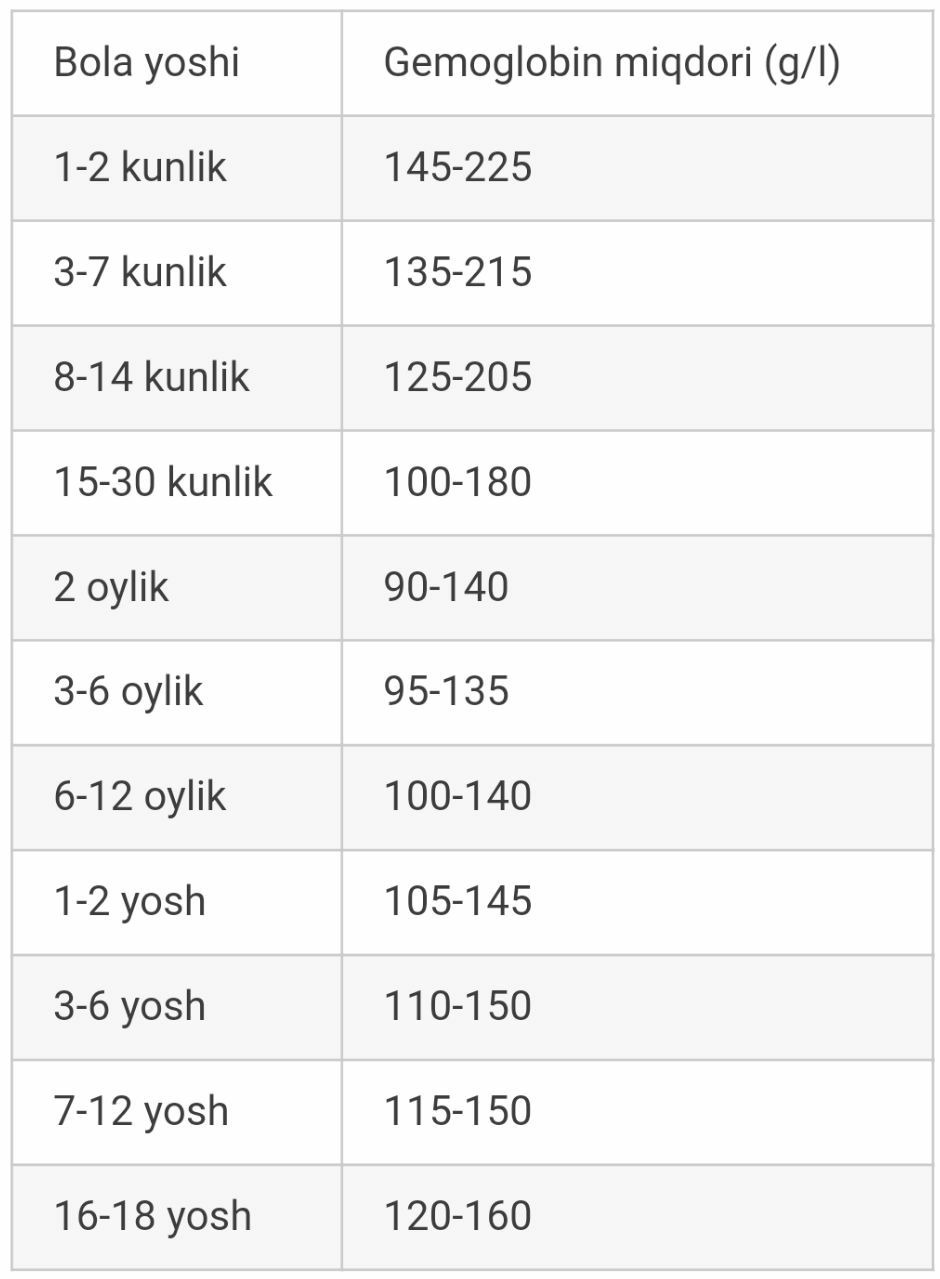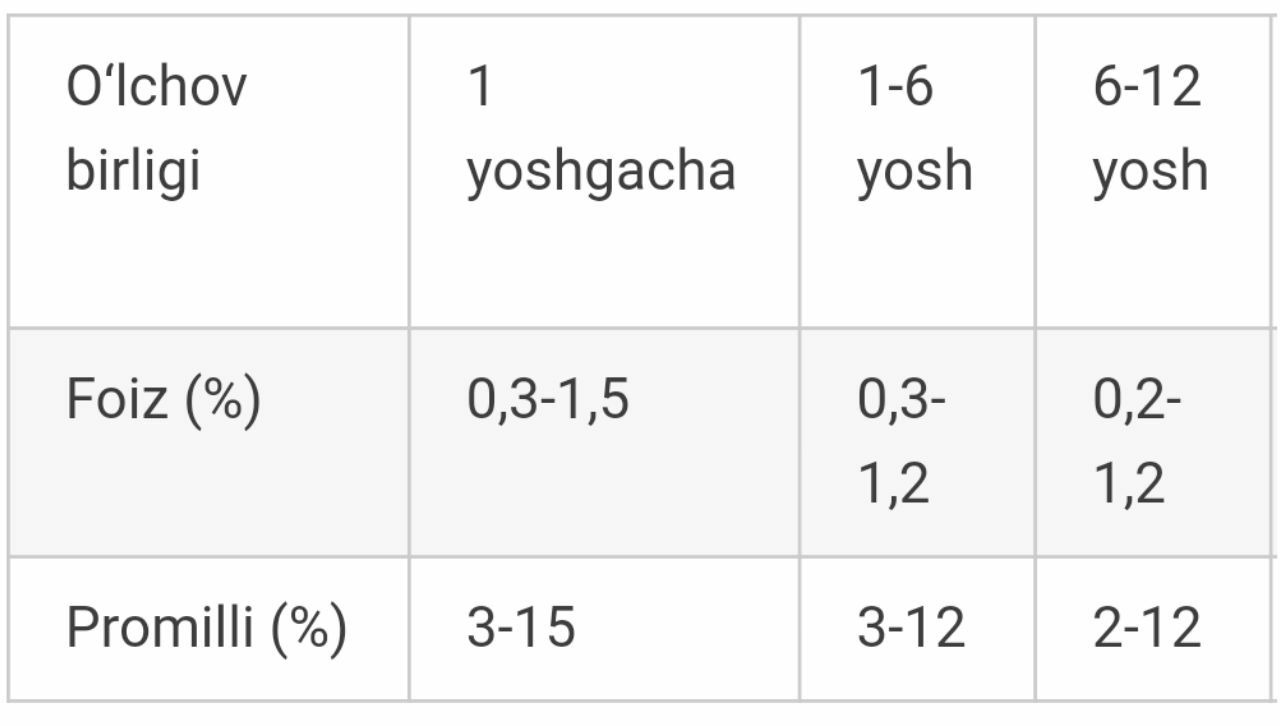SHARE WITH FRIENDS:
Anemia is a condition in which the amount of hemoglobin in the blood is below normal, one of the most common pathologies. Many young mothers are well aware of this pathology because one in two of them is with this condition pregnancyencountered in time. In children, anemia occurs not as an independent disease but as a complication of another disease. Therefore, it is necessary to find the factor that causes anemia and eliminate it.
According to WHO statistics, iron deficiency anemia is diagnosed in 25% of cases in infants, up to 4% in children under 43 years of age, 5% in children aged 12-37 years and 30% in adolescents.
The condition of anemia is considered by most parents to be non-serious. They simply think that we have found a solution to the problem by giving more iron-containing products in the diet. In fact, anemia is a sign of changes in a child’s blood production system, which can later lead to serious complications.
Types of anemia (classification)
Anemia - manifests itself in various forms. This condition manifests itself as a complication of many diseases, accompanied by a variety of symptoms, and the outcome of each condition is unique. With this in mind, several different classifications of anemia have been developed in the medical field to make it easier to diagnose and treat.
By color index
The color indicator shows how saturated the erythrocytes are with hemoglobin. Normally, this figure ranges from 0,8 to 1,1.
Hypochromic anemia
The most common pathology in children - in hypochromic anemia, the color index is less than 0,8.
This form of anemia includes:
- Iron deficiency anemia is a decrease in hemoglobin synthesis as a result of iron micronutrient deficiency in the body, which is caused by iron deficiency or excessive blood loss in food. This type of anemia is more common in children;
- Thalassemia (Ash anemia) is an inherited mutation in the hemoglobin gene that makes children mentally and physically retarded.
Normochromic anemia
In normochromic anemia, the color index is in the range of 0,8-1,1.
This type of anemia includes:
- Hemolytic anemia - in which erythrocytes break down faster than synthesized;
- Posthemorrhagic - anemia caused by excessive blood loss;
- Anemia caused by low synthesis of erythropoietin (this hormone is synthesized in the kidneys and is involved in regulating the production of erythrocytes);
- Neoplastic - the appearance of a tumor in the bone marrow;
- Aplastic is a condition that causes serious changes in a child’s bone marrow and often ends in death, making it very difficult to treat;
- Hypoplastic is a mild change in bone marrow that is safer than the above.
Hyperchromic anemia
In hyperchromic anemia, the color index is higher than 1,1.
This type of anemia includes:
- Vitamin B12 deficiency anemia or poor quality anemia, or Addison-Birmer disease - decreased blood production due to vitamin B12 deficiency, which damages the bone marrow and nervous system;
- Folide deficiency anemia is a hematological pathology caused by insufficient intake of folic acid in the body of the child. At the same time the formation of erythrocytes in the bone marrow slows down, turns into a megaloblast;
- Myelodysplastic syndrome (MDS) is one of the problematic pathologies in the field of hematology. A condition that results in bone marrow dysplasia leading to leukemia. However, it is rare among children.
Classification by severity
The basis of this classification is the amount of hemoglobin in the child's blood:
- Mild, grade 1 anemia - below normal, up to 90 g / l;
- Moderate, grade 2 anemia - in the range of 90-70 g / l;
- Severe, grade 3 anemia - less than 70 g / l.

According to the condition of the bone marrow
When there is a small amount of hemoglobin in the blood, the bone marrow tries to overcome this condition. At the same time the amount of reticulocytes (new erythrocytes normally 0,5-2%) increases. Depending on the amount of reticulocytes, the following forms of anemia are distinguished:
- Aregenerator (aplastic) - their complete absence;
- Hyporegenerator (vitamin B12 deficiency, iron deficiency) - less than 0,5%;
- Normoregenerator (posthemorrhagic) - 0,5-2% (norm);
- Hyperregenerator (hemolytic) - more than 2%.
Age-related normal rate of reticulocytes in a child's blood

Pathogenetic classification
Classification based on pathology associated with blood production.
- Autoimmune hemolytic anemia is the breakdown of erythrocytes by the body's own immune system antibodies;
- Posthemorrhagic - results from blood loss;
- Dysgemopoietic - anemia with dysfunction of the red bone marrow: the most common type is Daymond-Blackfen congenital anemia, which in 90% of cases is detected as soon as children are born;
- Deficiency anemias (vitamin B12, folic acid deficiency) - a lack of necessary substances.
Etiological classification
Anemia is not an independent disease, it is the result of an illness. Based on this, the following classification is made.
Infectious anemia:
- Tuberculosis;
- Bacterial endocarditis;
- Bronchiectasis;
- Lung abscess;
- Brucellosis;
- Pyelonephritis;
- Osteomyelitis;
- Mycosis.
Collagenous anemias:
- Systemic lupus erythematosus;
- Rheumatoid arthritis;
- Nodular polyarthritis;
- Horton's disease.
Age-specific specificity of blood
As the baby is born, its blood composition changes as it develops. His blood system adapts to the new conditions. The amount of hemoglobin and erythrocytes is constantly changing, especially in the period up to 1 year. This is why anemia also has age-related aspects.
Anemic conditions in infants are caused by a difficult pregnancy or a congenital genetic factor. Anemia in premature babies has been described since the twentieth century, and they can take many different forms.
Acquired anemia in infants of breast age is more common in children with weakened immune systems or poor nutrition (early transition to artificial feeding).
Treatment at this stage poses some difficulty because it is not possible to change baby food products. Only special artificial iron-rich artificial nutrients can be used on the advice of a doctor. transition) occurs in children.
In most cases, anemia is detected in early childhood and difficult to treat and severe anemias are diagnosed. Genetic mutations, hereditary factors, pathologies during pregnancy - All this will be determined in this period. Such children undergo changes in the blood system by the age of 3 - due to changes in lifestyle and eating habits.
Causes of anemia
The development of anemia in children is caused by several factors - external and internal, hereditary and acquired, pregnancy and postpartum, pathological and underlying factors. It is very important for parents to know the factors that can lead their children to anemia.
Causes during pregnancy
- Maternal anemia during pregnancy, measles;
- Malformation of the umbilical system and placenta;
- Smoking;
- Rhesus conflict.
Postpartum causes
- Injuries during childbirth;
- Premature birth;
- Low body weight;
- Hereditary diseases that cause erythrocyte breakdown.
Nutrition-related causes
- Same diet;
- Vegetarianism;
- Lack of vitamins;
- Lack of mode.
Circumstances that cause diseases
- Invasion of vomiting;
- Rickets;
- Oncological diseases;
- Intestinal diseases;
- Hepatitis;
- Infectious Diseases; tuberculosis, lung abscess, bacterial endocarditis, brucellosis, pyelonephritis, osteomyelitis, mycosis;
- Systemic lupus erythematosus;
- Horton's disease.
If an aplastic form of anemia develops due to hepatitis, the child is less likely to survive. They can be overcome in eating problems. In addition, erythrocytes are not produced "in vain" even if the children are sedentary, thickly dressed, and constantly lying in the same position, so it is necessary to ensure the active movement of the child.
Symptoms of anemia
In most cases, anemia goes away without symptoms. Parents accidentally find out when a child’s blood is submitted for analysis. However, if the child is cared for carefully, the symptoms specific to each type of anemia can be felt.
General condition
- Weak, tired;
- Attention decreased;
- Tired quickly;
- Headaches;
- Insomnia;
- Excitability;
- Noise in the ears.
Cardiovascular system
- Arterial hypotension;
- Functional systolic murmur;
- Tachycardia;
- Fainting;
- Heart failure.
Digestive system
- Dryness of the oral mucosa;
- Loss or decrease in appetite;
- Constipation / diarrhea;
- Cracks in the oral mucosa;
- Flatulence;
- Frequent recurrence in breast-fed children.
Changes in appearance
- Paleness of the skin, mucous membranes and nails;
- Hair Loss;
- Brittleness of nails;
- Tumors;
- Weight loss.
All of the above symptoms are symptoms of a disease. Therefore, it is necessary to identify the disease that causes anemia and eliminate it.
Diagnosis of anemia in children
If anemia is suspected in children, a pediatrician, therapist, or hematologist should be consulted. The basis of diagnosis is a blood test:
- General analysis of blood - hemoglobin, erythrocyte count and color index;
- Blood biochemical examination - to determine the amount of vitamins, bilirubin and iron;
- In rare cases, bone marrow puncture.
When anemia is diagnosed based on the results of the analysis, children are examined by a narrow range of specialists - gastroenterologist, rheumatologist, nephrologist, cardiologist and others.
Treatment of anemia
The complex treatment of anemia is based on four principles: improving nutrition and improving quality of life, treatment of the underlying disease, taking special medications and careful use of folk medicine. All this is prescribed by a doctor.
Medicomentosis treatment
There is no single cure for anemia because there are many diseases that cause anemia. First of all, it is necessary to eliminate those diseases. Still, there are helpful treatments.
Common treatments include:
- Blood transfusion;
- Bone marrow transplantation;
- Hemotransfusion;
- Iron preparations in tablet or injectable form (Ferrumlek, Sorbifer, Hemostimulin, Ferroplex, Tardiferon, Ferbitol, Ectofer);
- Folic acid;
- Vitamin B12;
- Glucocorticoids and anabolic hormones;
- Sanatorium-spa treatment, rest in mountainous areas: in such conditions the body tries to synthesize more hemoglobin.
Treatment of anemia using folk remedies
In iron deficiency anemia, folk remedies can also be used to treat children as directed by a doctor. Usually, with the help of folk medicine, latent anemia can be treated.
Drops:
Infusions made from namatak fruit are widely used in folk medicine for the treatment of anemia. This tincture is high in vitamin C, which helps in the absorption of iron in food.
Its dried fruits are used to make tinctures from namatak. A tablespoon of fruit is poured into a glass of water and boil for 10 minutes on low heat. It is then infused for half an hour, drunk before meals.
Besides:
- Honey;
- Dried fruits;
- Beets.
After cleaning the sugar beets in boiling water, cut them into cubes and put in a bowl. It can be consumed by mixing a small amount of sour cream.

Eating in anemia
Anemia in children under 1 year of age is mainly treated through diet. It is recommended to include iron-rich products in the diet. Of course, the diet is chosen depending on the individual characteristics and age of the child.
The best food to treat anemia in babies is breast milk. From 8 months of age can be given additional food: meat, buckwheat porridge. From 12 months - fish, fruits and vegetables. Sometimes hematologists recommend a table №11 for anemic children (5 meals a day). This table consists of the following products:
- Bread, pasta, flour products;
- Soup;
- Fish;
- Meat, liver;
- Cottage cheese, butter, cheese;
- Eggs;
- Walnuts;
- Buckwheat:
- Pea, bean soup;
- Vegetables, fruits and berries.
Complications and consequences of anemia in children
Anemia complications occur when they persist for a long time and are not treated properly. They can reduce a child’s quality of later life.
The most dangerous complications can be:
- Weakening of immunity;
- Heart failure (anemia causes heart strain);
- Lagging behind in coloring;
- Lagging behind in physical and mental development;
- Hypoxic coma;
- Bone marrow dysplasia;
- Leukemia;
- Transition to chronic form;
- Mortality can occur if the cause of anemia is excessive blood loss or genetic mutation.
If iron deficiency anemia is caused, it can be treated with drugs. However, modern medicine can also fail if serious changes are observed in the hematopoietic system, for example, the consequences of aplastic anemia often end in death.
Preventive measures
Prevention of anemia involves a decrease in the amount of hemoglobin in the blood and protection against its complications. Local pediatricians and parents themselves should be concerned about preventive measures as soon as the child is born.
- Regular blood tests;
- Premature infants are given iron supplements from 3 months to 2 years of age;
- Improving food quality;
- Creating a healthy lifestyle;
- Walking in the fresh air;
- Different exercises, playing games;
- Holidays in mountainous areas.
Anemia in children should not be ignored. This pathology aggravates any other disease and its complications can lead to serious changes in the later life of the child. That is why it is necessary to prevent anemia in time, because it is better and easier to prevent than to cure!
